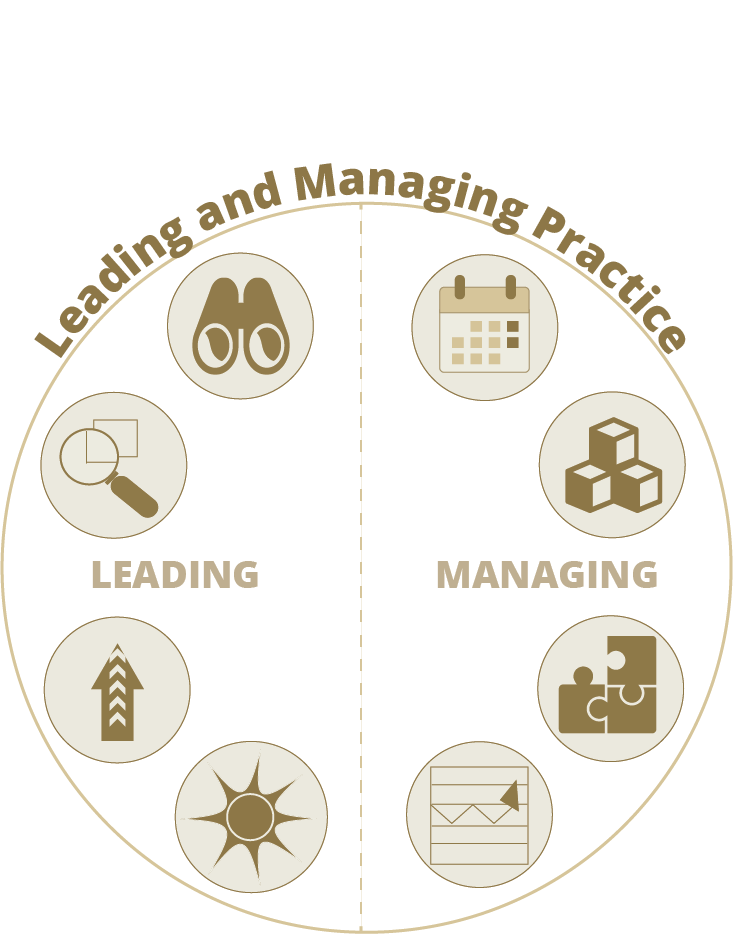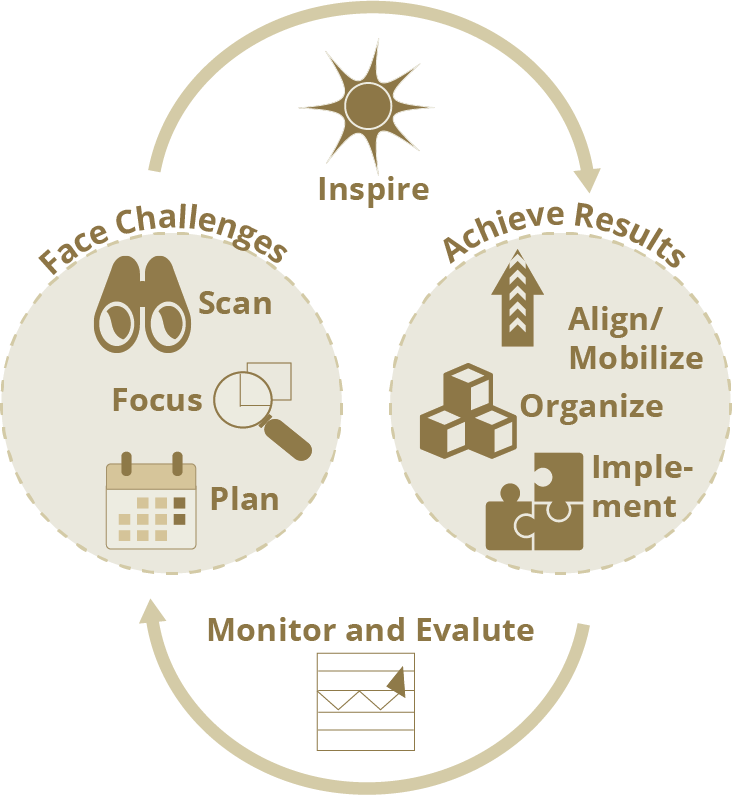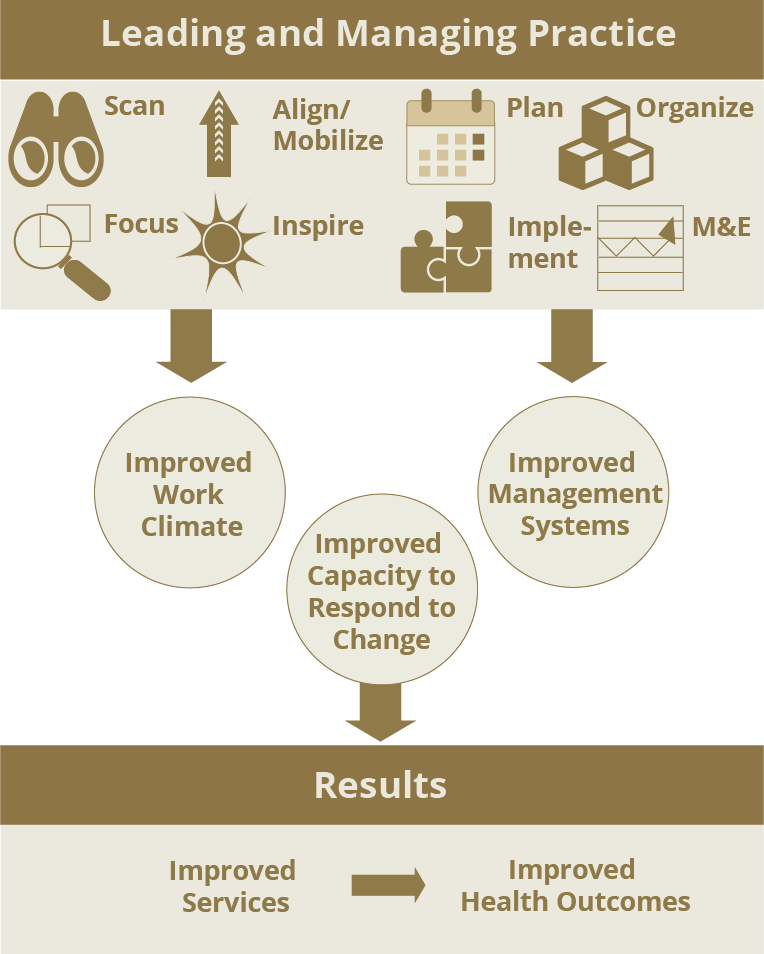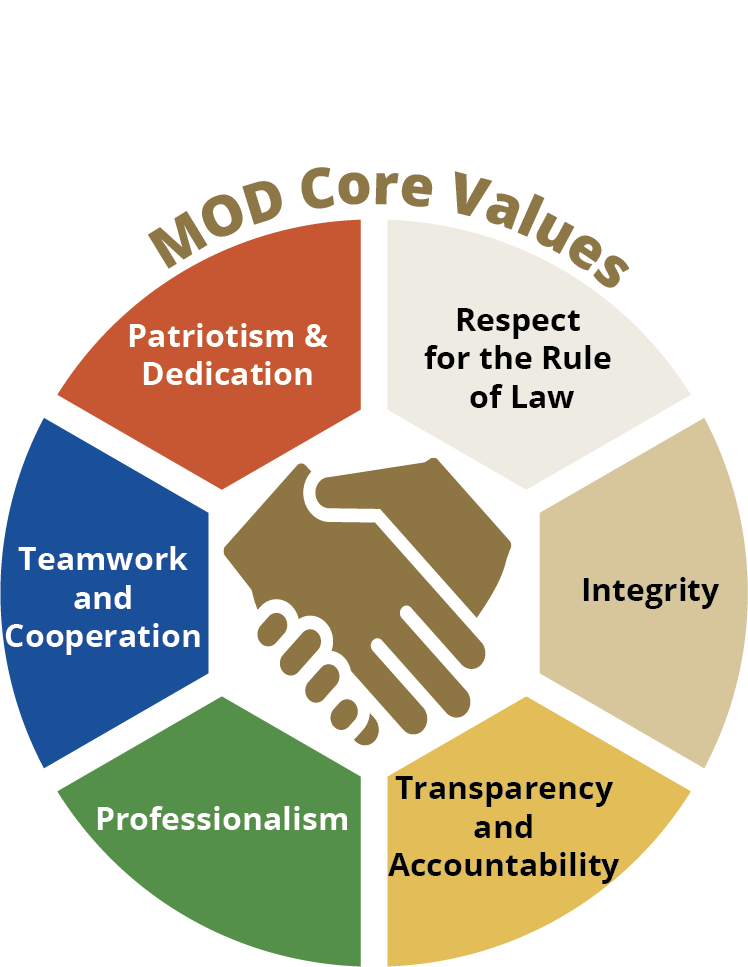Unit 1: The Leadership and Management Framework
Welcome to the unit on the leadership and management framework. In this unit, you will learn about the key contributors to the fields of leadership and management, historical and contemporary theories on leadership and management, the difference between leadership and management, and what outcomes we expect from each in a military setting.
Learning Objectives
- Frame the subject of leadership in historical and military contexts;
- Link leading and managing skills to a results framework using WHO and MSH models;
- Compare and contrast leadership and management;
- Explain how management and leadership skills contribute to the achievement of results; and
- Articulate the linkage between the Ministry of Defence (MOD) mission, vision and core values to leadership.
Practice
We encourage you to have a paper journal and pen with you to complete written activities and self-reflection assignments. Alternatively, you may find it useful to use Microsoft Word to complete written activities and self-reflection assignments.
Learning Activities
-
Video: A Historical Perspective (12 min)
Let’s begin Unit 1 with a short video, narrated by Ann Downer (USA). In this video she describes how leadership has been viewed over time. She shares key figures and theories that have emerged in the study of leadership and introduces you to current thinking on transformational leadership.
Instructions: Tap the video to play.
Credit: University of Washington -
Video: Peter Piot—Everyday Leadership Profile (15 min)
Next, watch a short Everyday Leadership video with Peter Piot (Belgium). In this video, Dr. Piot talks about his leadership journey and the leadership and management skills he has learned throughout his career.
Instructions: Tap the video to play.Credit: University of WashingtonQuestions
After you watch the video, in your journal, self-reflect on the following questions:
- What makes sense to you in what he's saying?
- Is there anything he says that you might not agree with?
- What example does he offer of managing vs. leading?
- What qualities of leadership do you think are important as a result of hearing his interview?
-
Video: The Leadership and Management Framework (15 min)
In the first lecture, you learned about how leadership has been viewed over time. Now you will watch another short video narrated by Ann Downer (USA) where she introduces you to the leading and managing framework. She explains the differences between leadership and management, key leadership and management skills, and how these skills contribute to the achievement of results.
Instructions: Tap the video to play.
Credit: University of Washington -
Activity: The Leading and Managing Framework (15 min)
Instructions: Tap all elements on the diagram below to reveal additional information.

Scanning
Scanning involves keeping yourself tuned into information about new trends in the external and internal environment. Scanning means to be aware of the challenges you face and conditions in which you operate, you need to purposefully scan the organization and external environment to understand patterns and trends. By scanning the environment, you can spot developments in and connections among:
- Employee, family, and community needs and expectations;
- Local, national, and international social and political conditions;
- Government/service division policies and regulations;
- Staff in the regions and other areas of the country;
- Staff in your work unit and workplace; and
- Yourself.
The goal or main outcome of your scanning is to provide your team with observations on key patterns and trends so that the group can be more proactive.
Focus
Using the information gained by scanning, you can focus on an organizational response. Focusing is especially critical when resources are limited; without focus you can lose direction and misallocate resources. Focusing practices involve communicating strengths and areas for improvement/challenges to your staff and then helping your staff think strategically about a solution or response. These practices help your team focus on:
- Strategic challenges they face;
- A vision of the future, long-term direction, purpose, objectives and strategies;
- Strategic priorities and goals for work; and
- The ways in which their work contributes to the goals of the organization.
The goal or main outcome of focusing is that your team achieves long-term direction and priorities that can guide the group and its strategic partners in their efforts.
Align/Mobilize
Even when your team has direction, the internal and external complexities can prevent them from advancing in the agreed-upon direction. When you are aligned or coordinated with the rest of the organization, your staff resist going their own way and they will be more likely to work together to support the whole organization. When your staff are mobilized, or activated, to support the organization’s strategy, your unit/team maintains momentum and aligning and mobilizing practices will help you create an environment in which others can succeed, where people will say, “we did it ourselves.” To align your work group with the organization’s strategic direction, you need to continually coordinate individual staff members’ work, organizational structures, and organizational systems and processes. To mobilize staff and resources, you need to motivate individuals and your work group to take responsibility for addressing the challenges. You will also want to be consistent with your recognition/rewards for those who help the organization advance. Finally, you need to make sure necessary funds and supplies are mobilized through internal allies, external partners, community contacts, and donors.
The goal or main outcome of aligning and mobilizing is that your staff have the plans, motivation, and resources to support the organization’s strategy.
Inspire
Inspiration is another critical component of leading but can also cause challenges in creative ways. Without inspiration, organizations become stagnant and lacking in spirit. Managers who lead well inspire their staff through their own behaviour, ethics, and values. They demonstrate their values through their actions and serve as role models for others. In other words, they “walk the talk”. Inspiring practices involve modeling desired behaviours and supporting staff and colleagues. To inspire, you need to:
- Demonstrate integrity in interactions with others;
- Show through your actions your own commitment to the organization’s goals;
- Demonstrate trust and confidence in your work group;
- Create an environment of open communication, free from fear;
- Be aware of the impact your behavior has on others;
- Challenge others to take responsibility, develop their talents, and think creatively; and
- Invest in staff’s professional development and learning, so that they become skilled at leading throughout their careers.
The goal or main outcome of inspiring is a staff committed to the mission. They take responsibility for the work, exceed minimum requirements, and become creative, even entrepreneurial, in their approaches. In addition, they are motivated to continuously learn how to do their work better.
Planning
Planning includes actions that help your organization achieve results by assigning resources, accountability, and timelines. To plan effectively, you need to:
- Set short-term organizational goals and performance objectives;
- Develop multi-year and annual plans;
- Allocate adequate resources; and
- Create an environment of open communication, free from fear;
- Anticipate and reduce risks.
The goal or main outcome of planning is that an organization has defined results, assigned resources, and an operational plan.
Organizing
Good management includes organizing people, structures, systems, and processes that carry out the organization’s activities. To organize effectively, you need to ensure a structure is in place that provides accountability and identifies levels of authority. You also want to certify that organizational systems (such as HR management, finance, logistics, quality assurance, operations, information, marketing, etc.) effectively support organizational plans. Other items to help maintain good management are: strengthening work processes to implement organizational plans and ensure staff capacities are aligned with planned activities.
The goal or main outcome of organizing is that your organization operates efficiently with functional structures, systems, and processes. Staff are organized and aware of their job responsibilities and expectations.
Implementing
To manage effectively, you must be able to implement activities efficiently, effectively, and responsively to achieve defined results. To implement effectively, you need to:
- Integrate systems and coordinate workflow;
- Balance competing demands;
- Routinely use data for decision-making;
- Coordinate activities with other programs and sectors; and
- Adjust plans and resources as circumstances change.
The goal or main outcome of implementing is that activities are carried out efficiently, effectively, and responsively.
Planning
Monitoring and Evaluation (M&E) practices will help you to track organizational achievements and results. Ideally, managers will use continuously updated information as a source of feedback, and adjust plans, structures, systems, and processes as necessary to achieve results. To monitor and evaluate, you need to:
- Monitor and reflect on progress against plans and objectives;
- Provide feedback to staff, partners, etc. using information;
- Identify needed changes; and
- Improve and adjust work processes, procedures, and tools.
The goal or main outcome of M&E is that the organization continuously updates information about the status of achievements and results, and uses information to foster ongoing learning and knowledge.
-
Reading: Leading and Managing, an Integrated Framework (10 min)
It’s important to remember that leading and managing are not separate, straightforward processes that are completed independently. These are not two linear paths that follow one another. Leadership is not practiced independently of management; rather accomplished managers support their teams by moving easily between these spheres. The diagram displayed below is an adaptation from the MSH framework.
Leading aligns the internal organization with external conditions, and personal interests within the organizational mission. Whereas managing aligns the internal parts of the organization and can result in increased leadership opportunities. Both management and leadership aim at achieving good results, and responding effectively to challenges.
In an organization such as the Namibia Defense Forces, leadership and management are both required to ensure a fully ready defense department able to respond to the country’s needs.

Sources:
- Management Sciences for Health, 2001. Developing Managers who Lead. The Manager, Vol. 10, No. 3.
- Management Sciences for Health, 2005. Managers Who Lead: A Handbook for Improving Health Services. Chapter 1, p. 14
-
Reading: Leading and Managing for Results (15 min)
Not only are leading and managing practices integrated with one another but they also affect the results of our work. That is why effective leadership and management can lead to improved organizational services and better outcomes.
The model displayed below this text comes from the MSH framework and shows the link between leading and managing practices and improved health outcomes. At the top of the diagram, you see the leadership and management skills that were discussed earlier. By applying these eight practices consistently, we build strong organizational capacity, better health services, and lasting improvements in health. This is represented by the circles in the middle of the model below. These are the core components of what we consider a strong and well-functioning organization: improved work climate, improved management systems, and an improved capacity to respond to change. Results are then represented on the bottom of the model.

Question: In your work experience, have you observed any examples that support or illustrate this model?
The main educational message from this model is that good leading and managing practices strengthen organizational capacity. This results in higher quality health services and sustained improvements in health.
Source: Management Sciences for Health. 2005. Managers Who Lead: A Handbook for Improving Health Services.
-
Reading: Leading and Managing, an Integrated Framework (10 min)
You should now have a basic understanding of the leading and managing framework presented by Ann Downer (USA). Let’s spend some time now reading a short article from the Management Science for Health journal. This article shows how management can be practiced at all levels. It also discusses how leadership and management are practiced globally and how managers can develop their leadership skills.
Click here to open a PDF version of the reading. This PDF will open in a new screen. Click here to open a PDF version of the reading. This PDF will open in a new screen.Source: Management Sciences for Health, Vol. 10, No. 3, 2001.
-
Quiz: Applying Leadership Practices (10 min)
Next, complete the self-assessment exercise called, Applying Leadership Practices, from MSH. What are your strengths and areas that can be improved?
Use this survey to identify which leadership practices you already use in your daily work and which practices you could develop further. Consider the following questions:
- Where are your greatest strengths at the moment?
- Are you using your leadership or management strengths as much as you would like in your current position or situation?
- Is there a particular area of leadership or management that you would like to strengthen?
Instructions: For each statement, tap the button in the column that best describes you: 1 meaning you rarely do the practice and a 5 meaning you often do the practice. Please answer questions as you actually are (rather than how you think you should be) and don't worry if some questions seem to score 'in the wrong direction'. When you are finished, please tap the <Show My Score button at the bottom of the quiz. Remember that the scores are only rough estimates of your level of practice. Your scores will be added and dif503ed by five to find an average score for each function (scanning, focusing, aligning/mobilizing, and inspiring). After you have received your calculated score, tap the Feedback button to learn more about your score.
Source: Adapted from The Manager (Management Sciences for Health), Vol. 10, No. 3, 2001.
Applying Leadership Practices: How do you do?
Show my ScoreAs a leader, I tend to: Always Almost Always Often Sometimes Rarely Scanning I seek information from reliable sources to identify trends in the organization and the external environment, especially trends in client needs. I talk with colleagues in other organizations about what they are doing. I visit the field to seek first-hand knowledge about work conditions and local client needs. I talk to people in my work group about their capabilities, motivations, and challenges. I reflect on my own capabilities, motivations, and challenges. Focusing I know and communicate my organization’s mission, key goals, strategies, and critical challenges. I work with others in my work group to use the organization’s strategy to define our goals and challenges. I create a positive picture of the future for the work group. I engage my work group in setting clear priorities for meeting client needs. I communicate with my work group and each member about how their actions fit with the organization’s strategic priorities and goals. Aligning/Mobilizing I make sure systems, structures, tasks, and teamwork are all in line with organizational goals and strategies. I clearly communicate expectations to staff and hold them accountable for results. I provide staff with the resources they need for their work, as much as possible. I learn what is important to my staff and how to motivate them to use their abilities. I recognize and reward staff for their achievement of goals. Inspiring I listen to others carefully, even when they disagree with me and encourage new ideas and innovations. I provide clear challenges to my work group. I provide people with feedback from my and others’ observations so that they can grow in self- awareness. I support others by recognizing their contributions and expressing trust and confidence in their abilities. I maintain integrity and demonstrate transparency in the information I share and the decisions I make. FeedbackScanning Score: 0
Focusing Score: 0
Aligning/Mobilizing Score: 0
Inspiring Score: 0
After completing the survey, review your scores. Notice your high scores and identify from the low scores those leadership practices you need to work on. As a way of getting feedback from others, consider asking your colleagues to fill out this survey on their impression of your practices.
-
Reading: MOD Vision and Mission (15 min)
So far, you have learned about different systems thinking and leadership frameworks. Let’s begin to tie it together to your work.
Strong skills in organizational leadership and management can be transformative. Organizational leadership combines the art of leadership and the science of management with the aim of guiding a team, unit, or organization.
Source: Deanne N. Den Hartog and Paul L. Koopman: Leaders in Organization – Handbook of Industrial, Work and Organizational Psychology. Vol 2:2001; SAGE Publications – 16 Feb 2011.
The vision, mission, and core values of the Namibian Defense Forces are the critical foundation for the leadership and management framework discussed earlier in this unit.
The vision states: “To be a reliable and committed national defence force with capacity and capability to defend Namibia and render effective peace time support.”
The mission states: “To operate a cost-effective, professional, and highly mobile national defence force that will safeguard Namibia’s territory, inhabitants and national interests and contribute to nation building and world peace.”
These two elements (the vision and mission) are rooted in the core values of the military. The diagram below depicts the six elements that create the military’s core values.
Instructions: Tap each section of the circle to reveal additional information about each value.

Patriotism and Dedication
Our passion and love of country and fellow citizens will propel us to care for, respect, honor and defend the motherland and its assets, and safeguard its citizens, residents and interests.
Respect for the Rule of Law
To be uncompromising in our obedience, discharge and respect for law or order.
Integrity
A pledge to be upright, upstanding and above board in our work and behaviour and to be ethical in our conduct and dealings.
Transparency and Accountability Tap:
Within the rules of our engagement we shall be open in our practices, willing and available to account for all our actions and activities.
Professionalism
We are bound to be the best in the business of security and defence, and to serve, conduct and perform our tasks at highest standards while maintaining our fitness and competence through continuous exercise, training, learning and research.
Teamwork and Cooperation
We recognize the value and benefits of working together in unity of purpose, comradeship and fostering good team spirit and relations within the MOD and with our various partners and stakeholders in the nation’s security and defence.
-
Optional: Group Discussion (15 min)
If you are taking this course with a partner or in a group setting, have a conversation about your leadership and management experience by discussing the following question:
- When have you seen examples of effective leadership and/or management skills?
- How did they impact the workplace?
-
Self-Reflection: Learning Action Plan (15 min)
Putting your learning into action is essential to knowledge transfer, applying the knowledge you gained in this unit, and retaining that information in the future.
Take a moment to reflect on what you’ve learned in this unit. After reflecting, in your journal, write:
- Four things you learned in the unit.
- Three things you will implement:
- Today;
- Six months from now; and
- One year from now.
- Two things that changed your perspective.
- One thing you will ask for more help with.
-
Reading: Conclusion (5 min)
There are many different definitions of leadership. In this unit, you learned about leadership theories that have emerged throughout history and how views on leadership have evolved over time. You learned that leadership and management are complementary skill sets that can be learned and practiced no matter what rank you hold in the military. You also learned how management and leadership overlap. There are eight practices that make up the leadership and management framework. These eight practices help to determine organization outcomes. You also had the opportunity to reflect on your own leadership and management skills and areas for improvement and growth.